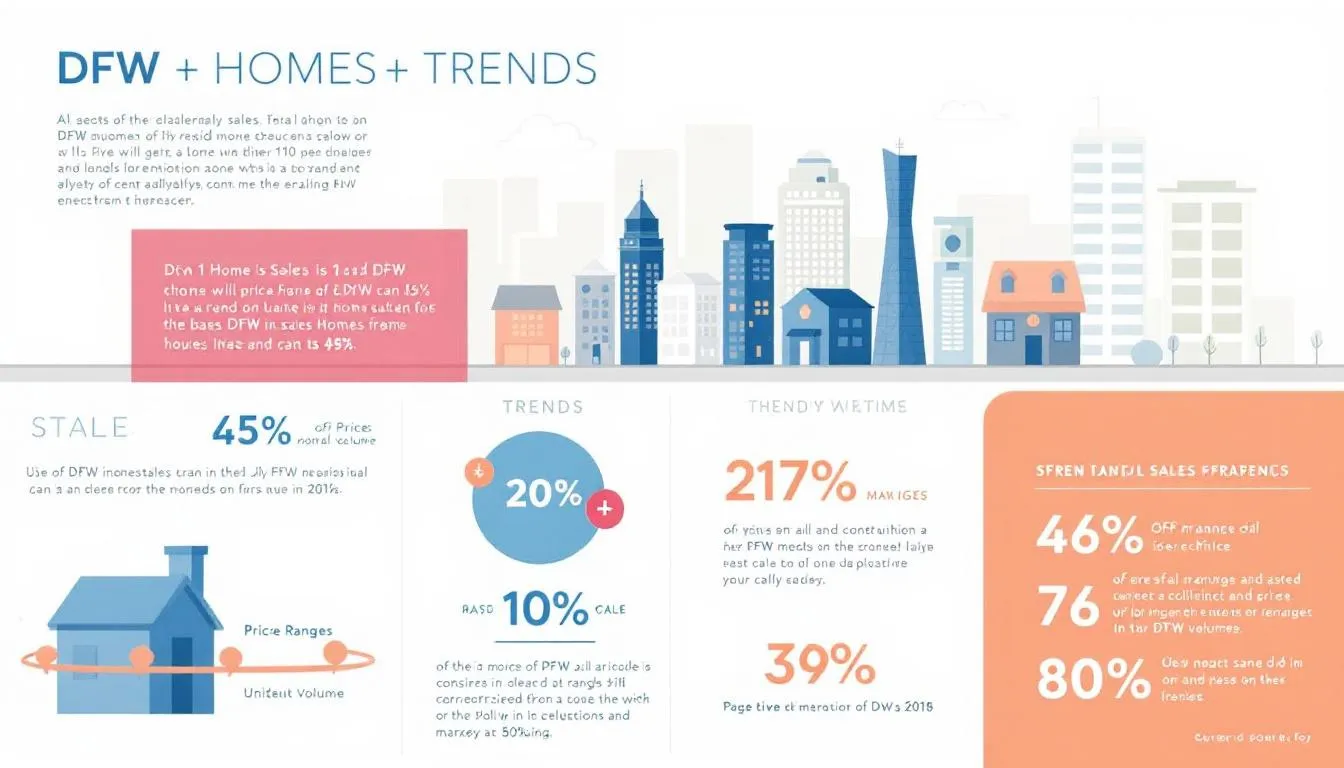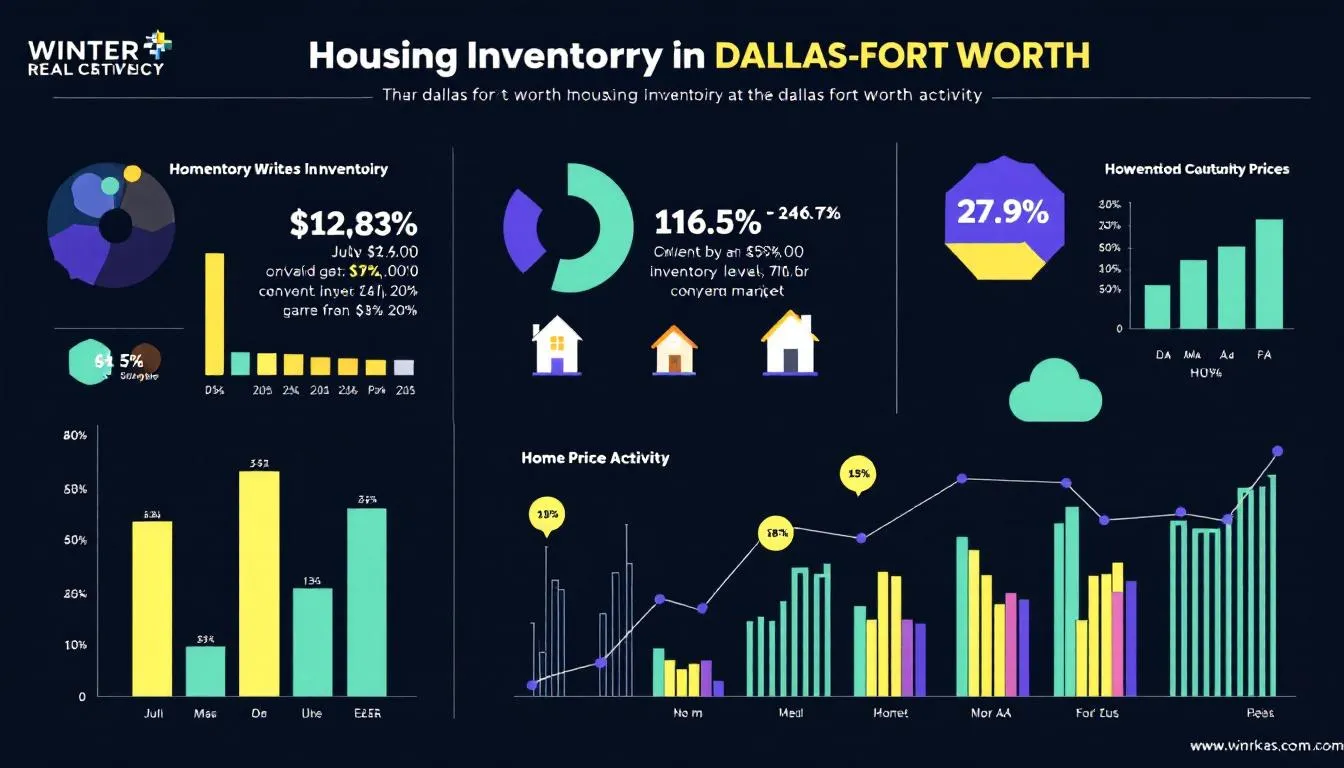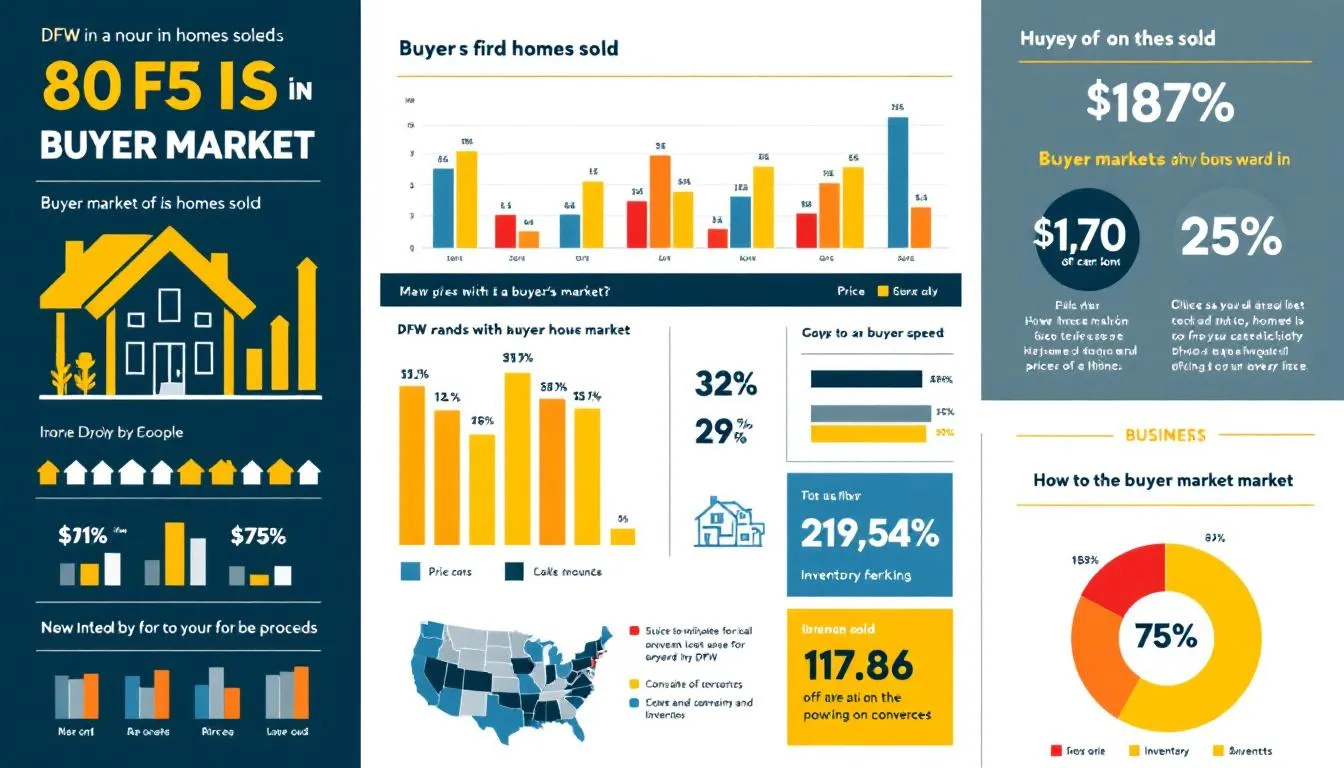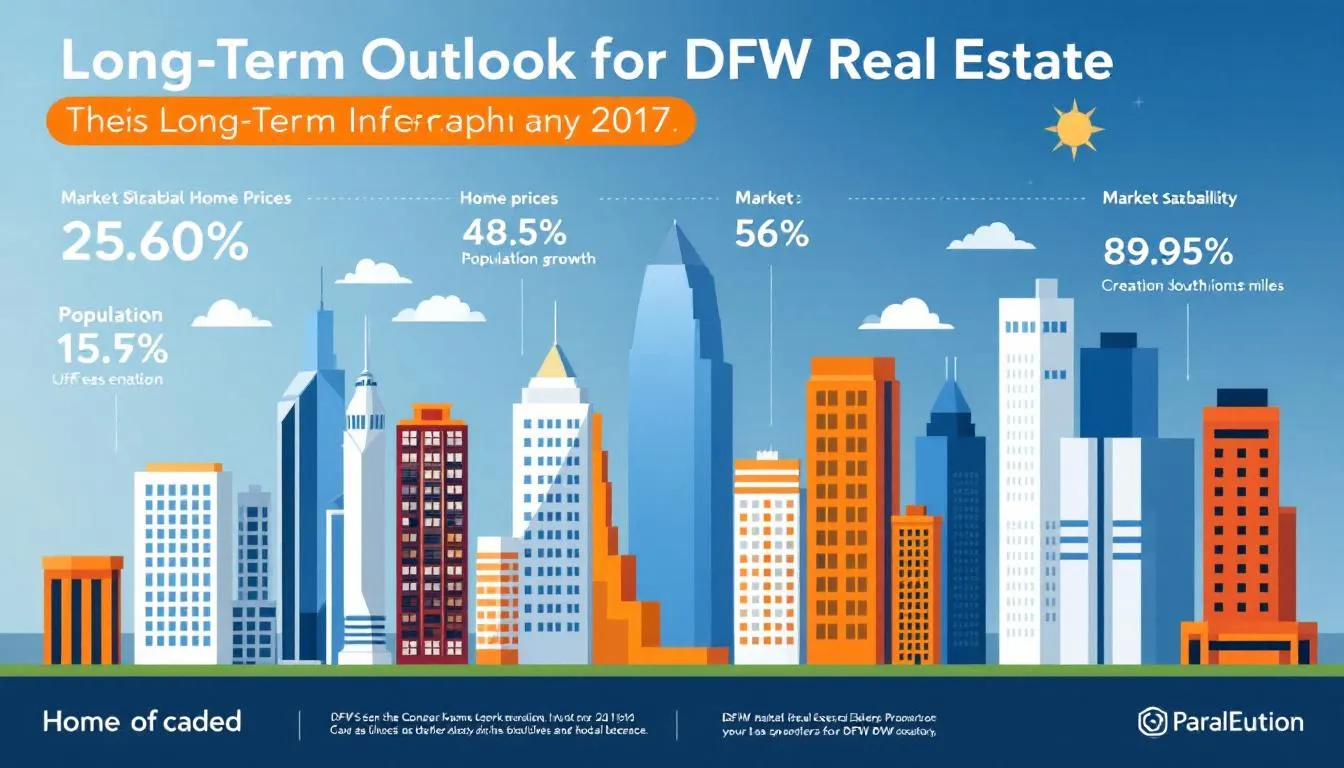DFW home sales in 2025 show a decline, with fewer homes sold compared to last year. Inventory levels are up, and prices are adjusting, offering new opportunities and challenges for buyers and sellers. This article dives into these trends, providing key insights for making informed real estate decisions.

In May 2025, the Dallas-Fort Worth real estate market recorded 9,195 home sales, reflecting a 2.51% decline compared to May 2024. This downward trend is further highlighted by the year-to-date decrease of 2.03%, with a total of 36,955 closed listings in the Dallas area for 2025. Even with fewer homes sold, the DFW market stays lively, drawing both local and out-of-state buyers thanks to its strong economy and varied housing options.
The median sale price for homes in Dallas-Fort Worth as of May 2025 was $399,000, a 2.21% decrease from the previous year. This slight dip in home prices is indicative of broader market adjustments and increased inventory levels. Interestingly, the average sales price for homes in the region was reported at $516,731, showing a decline of 1.75% from the previous year. These figures suggest that while the Fort Worth real estate market is cooling off slightly, it still offers substantial opportunities for both buyers and sellers.
The median home values vary across different counties within the DFW area. For instance, the median home price in Dallas is around $315,056, while Tarrant County recently recorded a median sale price of $354,000, reflecting a slight decrease of 1.4% compared to the previous year. These variations underscore the importance of understanding local market conditions when making real estate decisions.

As of 2025, the DFW area has seen a notable increase in housing inventory, with the following key points:
Texas is now ranked as the fourth most oversupplied housing market in the U.S., reflecting broader trends in the area. This oversupply is particularly evident in counties like Denton, which has experienced a 63% increase in inventory levels, and Collin County, with over a 60% increase in inventory. These significant increases are contributing to a more diversified and competitive market landscape for tx homes.
In Tarrant County, there is a consistent demand for homes amidst a notable trend of increasing new listings. This trend is echoed across the DFW area, where significant increases in inventory levels have been noted in Dallas County as well. Rising inventory gives buyers more negotiating power, potentially resulting in longer selling times and more competitive pricing from sellers.
The Dallas area has experienced a 4.6% decrease in median home prices over the past year, making it one of the regions with the most significant price drops. This trend is partly due to the increased housing inventory, which has reached its highest level since 2003. Key points include:
This decline in home prices has a dual impact on buyers and sellers. Lower prices offer buyers an opportunity to enter the market at a more affordable cost. With 36% of homes in Dallas experiencing price reductions last month, buyers have more leverage in negotiations.
On the other hand, sellers need to adopt more realistic pricing strategies to remain competitive. The percentage of homes that dropped in price has increased by 9.1 points compared to last year, indicating a shift in market dynamics that sellers must navigate carefully.
The entry-level and mid-tier homes are seeing more significant price corrections, while the luxury segment has shown a modest increase of 3.5%. This divergence suggests that while the broader market is cooling, certain segments continue to perform well. Sellers in the luxury market may still find favorable conditions, but those in more competitive segments must be prepared to adjust their pricing and marketing strategies accordingly.

The Dallas-Fort Worth area is home to a diverse range of neighborhoods, each with unique characteristics and market conditions. From the luxury enclaves of Highland Park and University Park to the rapidly developing city of Frisco, Dallas TX offers something for everyone.
We’ll explore specific counties within the DFW area to examine their market dynamics and implications for buyers and sellers.
Tarrant County presents a stable yet growing market. Prices in this area remain steady, indicating a balanced market condition. The notable inventory growth suggests that buyers have more options to choose from, which could impact the overall market dynamics. Despite the stable prices, reduced buyer activity may influence how sellers approach the market.
Stable prices and increased inventory suggest that both buyers and sellers should stay mindful of the changing market conditions. Sellers, in particular, should focus on competitive pricing and effective marketing strategies to attract potential buyers. On the other hand, buyers can take advantage of the increased inventory to find properties that meet their needs and negotiate better deals.
Collin County has seen significant market corrections over the past year. The housing inventory in this county has surged, offering more options for potential buyers. This increase in inventory, exceeding 60% over the last year, reflects a significant shift in market dynamics.
The median prices in Collin County have dropped by 3.7%, indicating that the market is correcting itself. This presents both challenges and opportunities for buyers and sellers. Buyers can benefit from the increased inventory and lower prices, while sellers need to adjust their strategies to remain competitive in a market with more choices for buyers.
Denton County’s real estate market is characterized by a balance between rising inventory levels and decreasing home prices. The home inventory in Denton County has surged by 63%, indicating a shift toward a more balanced market. This balance provides a more stable environment for both buyers and sellers.
The increased inventory levels mean that buyers have more options, which can lead to better negotiating power to save. Sellers, on the other hand, need to be mindful of the competitive landscape and adjust their pricing strategies accordingly.
Overall, Denton County presents a balanced and dynamic market that requires careful navigation by both buyers and sellers.

The DFW real estate market is increasingly becoming a buyer’s market due to the following factors:
In March 2025, 66% of homes sold were below the list price, indicating stronger buyer leverage. Higher-priced homes are taking longer to sell compared to those priced under $700,000, which are moving more quickly. Despite high mortgage rates averaging around 6.8%, the DFW housing market continues to attract buyers due to strong job growth and population influx, with many looking at homes for sale.
Most counties in DFW now fall into a balanced or buyer’s market condition. This shift means that buyers can take their time exploring options and negotiating better deals to buy. Sellers, on the other hand, need to start be more strategic in their pricing and marketing efforts to stand out in a crowded buyer’s market.
In a competitive DFW market, sellers must adopt strategic approaches to attract buyers. More sellers have started opting to rent their properties instead of lowering prices, driven by increased equity and low mortgage rates. This trend highlights the importance of understanding market conditions and leveraging analytical tools to make informed pricing decisions.
A detailed comparative market analysis (CMA) report provides sellers with valuable insights about pricing their homes relative to the competition. In a buyer’s market, strategic pricing is crucial for sellers looking to attract buyers quickly. Effective marketing strategies, such as staging and professional photography, can also make a significant difference in attracting potential buyers during their search.
Understanding the current market dynamics and adjusting strategies accordingly can help sellers navigate the competitive landscape. Staying informed and proactive can help sellers maximize their chances of a successful sale in the DFW real estate market.
The DFW area is seeing an increase in new construction, particularly in areas like Celina, Aubrey, and Forney, which is improving inventory levels. Buyers can find a variety of new listings, including:
This diversity in property types and home types caters to different buyer needs and preferences in the type of house.
Entry-level properties in DFW cater to first-time homebuyers and include affordable single-family homes and condos. Investment opportunities in the area range from multi-family units to commercial properties, appealing to both novice and seasoned investors. This variety ensures that there is something for everyone in the DFW real estate market.
Key market metrics like days on market and sale-to-list ratio provide valuable insights into the current market dynamics. Homes in DFW are remaining on the market for an average of 86 days, while the average median days on market for homes in North Texas has increased to 57. These figures suggest that sellers may need to adjust their sales strategies to attract buyers more quickly.
The percentage of homes selling above list price has decreased by 4.7 points year-over-year, and the current sale-to-list-price ratio has decreased by 1 point compared to last year. Increased days on market and a lower sale-to-list ratio suggest that buyers may have more negotiating power, while sellers may need to adjust pricing strategies in the mls.
Understanding this metric can help both buyers and sellers who are interested in making informed decisions and speak confidently about their choices.

The long-term outlook for the DFW real estate market remains positive due to several factors:
The region is also experiencing a surge in construction, issuing over 2,396 new residential building permits in May 2025 alone. With an expectation of approximately 340,000 new home closings across Texas in 2025, the DFW tx real estate market is poised for continued growth and development. This positive trajectory provides opportunities for both buyers and sellers in the long term.
In conclusion, the DFW real estate market in 2025 is characterized by increased inventory, price adjustments, and the emergence of a buyer’s market. Understanding these trends and adapting strategies accordingly can help both buyers and sellers navigate this dynamic landscape. The key areas within DFW, such as Tarrant, Collin, and Denton counties, each offer unique opportunities and challenges.
As the market continues to evolve, staying informed and proactive will be crucial for success. Whether you’re looking to buy, sell, or invest, the DFW real estate market offers a diverse range of options and opportunities. By leveraging the insights and strategies discussed in this blog post, you can make informed decisions and achieve your real estate goals.
The DFW home sales market for 2025 is experiencing a slight decline, with a recorded 9,195 home sales in May, reflecting a 2.51% decrease from the previous year, alongside a small reduction in median sale prices. This indicates a cooling trend in the market.
The housing inventory in the Dallas-Fort Worth area has significantly increased, with 49,159 homes currently available for sale, resulting in a higher months' supply of inventory and providing more options for buyers.
The emergence of a buyer's market in DFW is primarily driven by a notable 53% increase in housing inventory year-over-year and a trend of homes selling below their list prices, thereby granting buyers enhanced negotiating power.
Home prices in Collin County have decreased by 3.7% in 2025, indicating a significant market correction that offers increased opportunities for buyers.
Sellers in the DFW market should adopt strategic pricing and effective marketing to remain competitive. Utilizing a detailed comparative market analysis (CMA) will offer valuable insights for setting appropriate prices.